Squat Master Class
Build bigger, stronger legs with the "King of Exercises" – the barbell squat. This squatting seminar will provide the basis of your lower body training.

Build bigger, stronger legs with the "King of Exercises" – the barbell squat. This squatting seminar will provide the basis of your lower body training.

Note: The above video was recorded as Facebook Live tutorial in conjunction with the Train With Jim Tabata Builder program.
In the world of powerlifting and bodybuilding, the squat is arguably the most technical exercise there is, with the largest skill component. But it’s also the best mass-building movement known to man for the lower body, so it’s worth learning how to do it correctly to build size and strength in the safest manner possible.
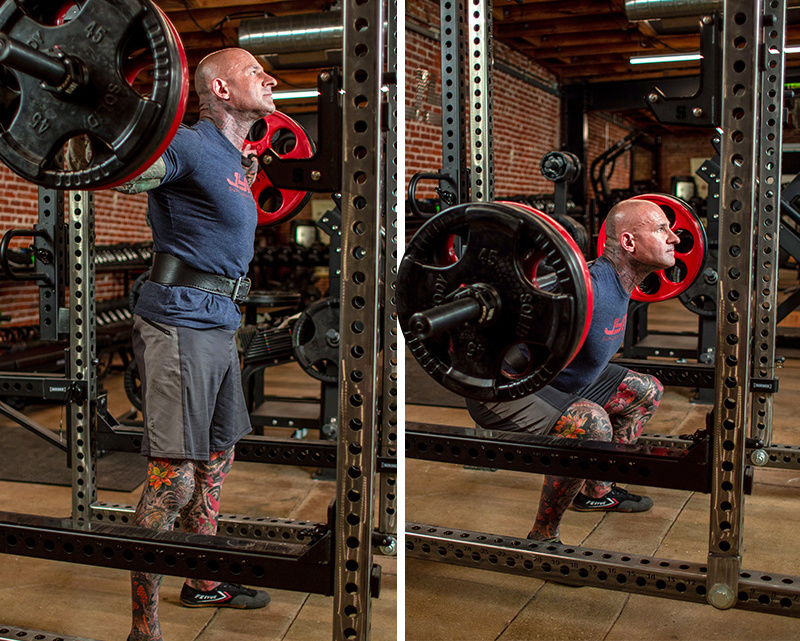
When we talk about squatting, there’s one bodypart in particular that’s always mentioned first and foremost, and for good reason: the ass.
When doing a squat, at least on the descent, you always want your ass (glutes) moving back. And the reason why has to do with your center of gravity – you want your center of gravity to be as far back as possible. This is challenging, of course, because you have a barbell on your shoulders that wants to push your center of gravity forward, so you’re fighting against that to stay back.
The last thing you want when squatting is for your center of gravity to move too far forward. When it does, you’re going to round your lower back and flex at the spine. Doing this with weight on your back is very dangerous for the health of your spine.
You generally know when your center of gravity is too far forward because your heels come off the floor and your knees move forward and past your toes. This is NOT what you want. The heels should stay on the floor throughout the squat.
One interesting thing about squats is that it’s actually harder to keep your center of gravity back when using very light or basically no weight (like a broomstick or unloaded barbell) versus a loaded barbell. When you have a substantial weight on the bar (even just 135 pounds), it helps keep you back. If you’re an experienced lifter, you know how to use that weight to stay back; novices and beginners are more prone to letting the weight pull them forward, which is why starting off light and honing squatting technique is crucial.
A bodyweight squat is great to use as a warm-up and to practice proper form, but it’s best to counterbalance your weight by putting your arms out in front of you; this will help you stay back on your heels.
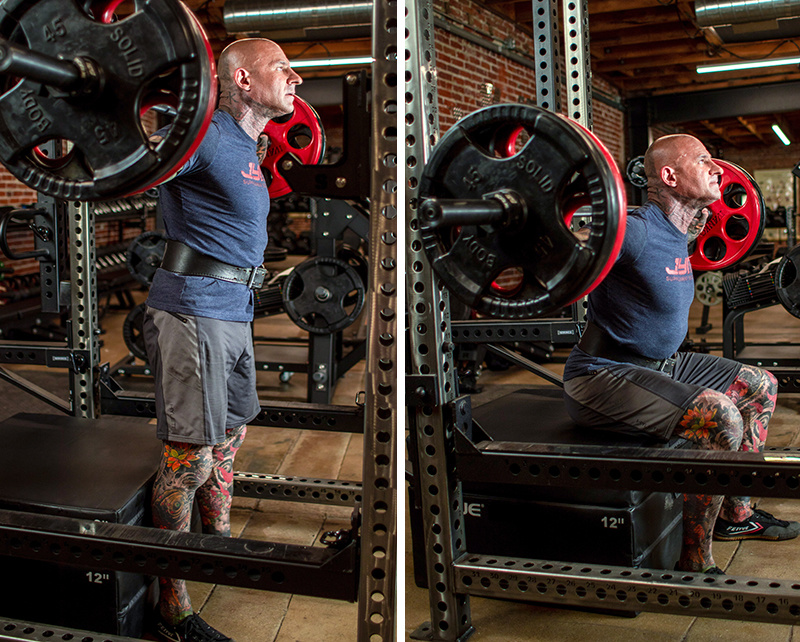
So, what should you do if you have trouble keeping your center of gravity back when squatting? Try bringing a plyometric box into the exercise and squatting down to it – powerlifters call this specific variation a box squat.
Having the box beneath you gives you something to squat down to. It also stops your momentum. On a normal squat (without a box), you go down and then come right back up. As you lower down, you’re storing energy in your quads, hamstrings, and glutes so that as you come up you get a little snap, just like an elastic band. That little bounce you get out of the hole at the bottom of the squat is the elastic property resulting from the stretch in the muscles right before contracting to stand back up.
With box squats, you’re not going right back up, so you lose some of that elastic energy. Stopping at the box makes the squat a little bit more like a deadlift, because you’re coming out of the hole from a dead stop instead of bouncing back up with the help of the stored energy and the elastic effect. Coming from a dead stop like this is a great way to build power in the lower body.
But you know what else is happening with the box squat? It’s allowing you to sit back further. That’s what I want to be doing when squatting – pushing that butt back. A lot of people are afraid to do that when there’s nothing underneath them; the fear is that you’ll push back too far and fall backward with the weight.
The key with box squats is to get a box (or bench or chair, whatever) low enough so that your quads reach parallel to the floor at the bottom of the rep.
Another major key on the box squat is that you’re not actually sitting and relaxing at the bottom. You want to stop momentarily at the box with your butt touching it, but you want to maintain the tension in the lower body and keep the core tight. And you always want to keep a slight arch in the lower back and your chest out. This isn’t like sitting down on a chair at home to watch TV – you’re not relaxing at the bottom.
You may hear people (powerlifters, usually) mention different types of barbell squats – namely, high bar squats and low bar squats. What’s the difference?
With a high bar squat, the bar sits at the top of the upper traps, right at the base of the neck. The hands are also fairly close together to keep the bar in place and up high.
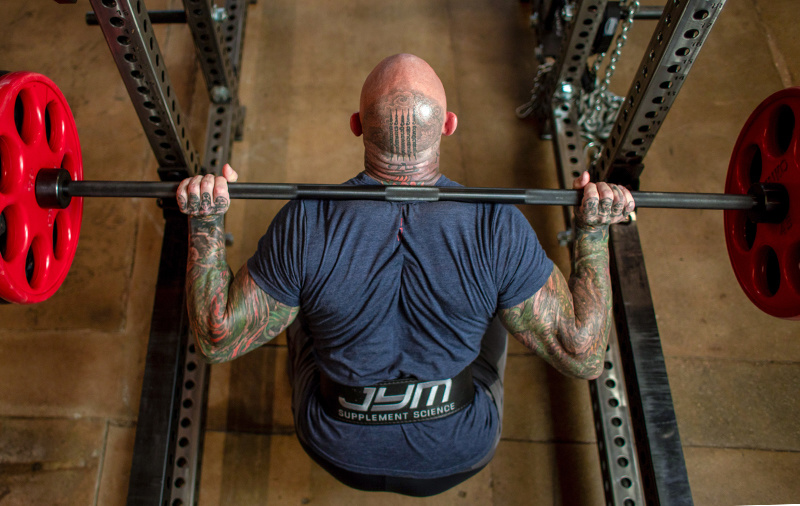
With a low bar squat, the bar sits a few inches lower than the high bar version, right in the middle of the upper traps. Most people (myself included) like the hands to be very wide on the bar, all the way out to the plates even, to help keep the bar stable in the lower position.
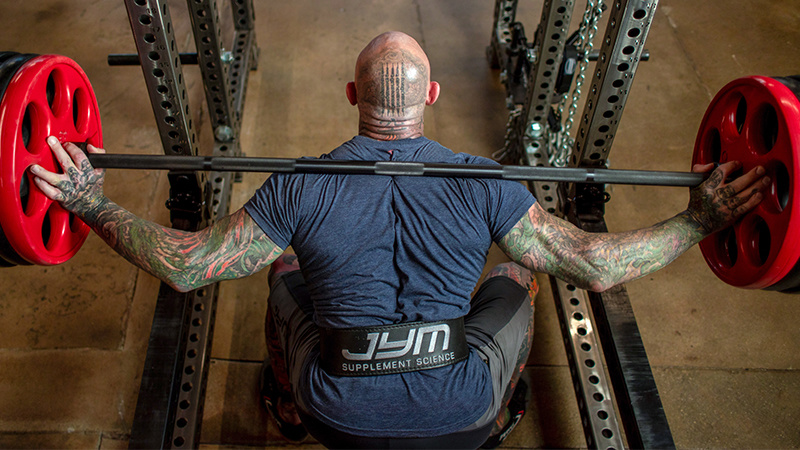
Now, the crucial difference between high bar and low bar squats has to do with the angle of the torso.
With high bar squats, the torso remains more upright in order to keep the bar in place and not putting too much pressure on the vertebrae (which would occur if you started leaning too far forward). With the low bar squat, the torso needs to lean further forward to keep the bar from sliding down the back.
From a lower body anatomy standpoint, these torso positions make a difference in what areas are targeted.
With the low bar squat (and subsequent forward torso lean), I’m getting more hip flexion and extension. This is essentially a hip hinging type motion, so the glutes and hamstrings are getting more work.
With the high bar squat, the more upright torso position means less hip flexion and extension and more flexion and extension at the knee. Because of this, the quads are emphasized to a greater degree than they are on low bar squats.
The high bar squat is usually favored by Olympic lifters. Why? Because their two main lifts – clean and jerks and snatches – involve squatting motions where the weight is in front of the body (front squat for the clean and jerk, overhead squat for the snatch). The upright torso position of the high bar squat better mimics these positions. (This is also why Olympic lifters do a lot of front squats in their training.)
Believe it or not, you can also change the emphasis of a squat (hitting either more quads or more glutes) by adjusting the weight.
Research shows that when you're squatting with anything greater than 80% of your 1-rep max (1RM) – basically, anything over your 8-rep max – you tend to use more glutes and hamstrings. Conversely, anything lighter than 80% of your 1RM (ie, your 10RM, 12RM, 15RM, etc.) tends to hit more of the quads. This holds true whether you’re doing a high bar or low bar squat.
And why exactly would going lighter or heavier, and doing more or fewer reps, change the muscle involvement? It comes down to biomechanics. What would happen if I had 135 pounds on the bar and I bang out 20 reps of squats? Or, let’s say I throw on 405 and do only three reps. What's going to happen?
First of all, the weight is pushing me down more with the heavy weight, so it's causing me to push my torso a bit more forward. What does that mean? It means my torso is not as upright with the heavier weight. I've got more flexion at the hips as I come up with the heavier weight, which is going to force the torso more forward and cause the glutes and hamstrings to work harder to get the torso up and support the weight. A lighter weight, on the other hand, isn’t pushing you as far forward. It's really that simple.
So, think about this when you’re deciding what areas of the lower body to focus on. Are you trying to bring up your hamstrings more, or your quads? Now, this doesn’t mean you should only use light weight on squats when emphasizing the quads; you always want to mix things up with a variety of resistances and squatting variations. But if you want to bring up your quads, you might consider focusing more on higher reps with squats from time to time.
A lot of people talk about going wide versus going narrow on squats, but they often get it backward. Conventional wisdom says that if you go with a narrow stance on squats, it hits the outer quads (vastus lateralis), and that a super wide stance hits the inner quads (vastus medialis).
But this doesn’t appear to be the case. An Italian study that was done not too long ago looked at muscle activation in wide- versus narrow-stance squats, and here’s what they found…
A narrow stance actually hit more of the vastus medialis (inner quads) than the lateralis. And when the subject went into a super wide stance, it increased glute activation, which is what we all believed before that. But wide-stance squats also hit the vastus lateralis (outer quads) more so than a narrow stance.
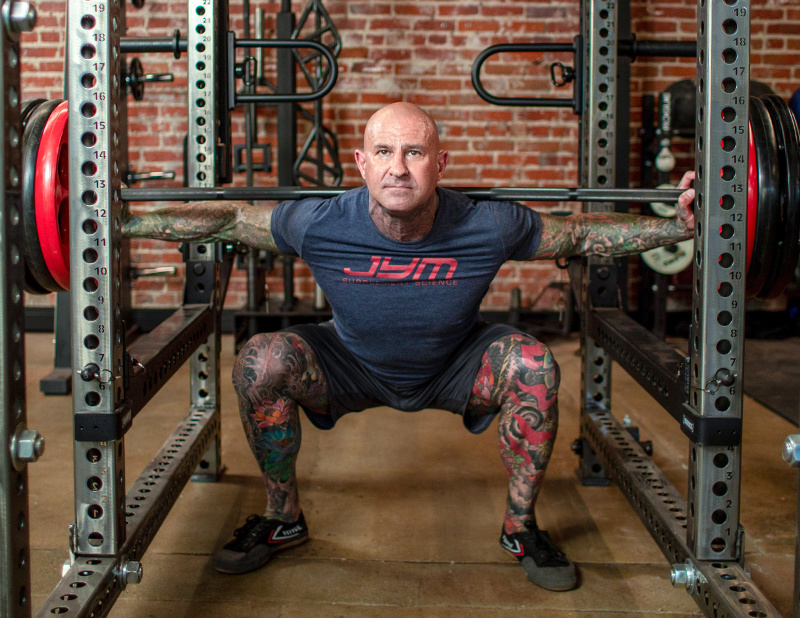
The reason for the confusion seems to be that people aren’t considering other thigh muscles aside than the quads. For example, the gracilis, an inner thigh muscle that’s an adductor (meaning, it brings the leg inward toward the midline of the body). When you do a wide-stance squat, it doesn’t hit more of the inner quads, but it does hit more of those adductors. So the take-home here is that, yes, wide-stance squats hit the inner thighs to a greater extent, but not necessarily the inner quads. This may be a subtle difference to some people, but it’s worth taking into consideration when selecting different types of squatting variations.
So, do wide-stance squats to bring up the glutes and outer quads, and narrow-stance squats to hit the inner quads. Speaking of inner quads, the vastus medialis is what’s known as the “teardrop” muscle at the top of the knee that most guys want to develop. Aside from doing narrow-stance squats, you can target the teardrop with partial range of motion squats, like half squats and even quarter squats.
Obviously, I'm a huge proponent of doing full range of motion squats, as that’s the best way to maximize overall leg development. But there’s a time and a place for partial reps – particularly for those who want to develop that teardrop muscle. But doing so isn’t just about your legs looking good in a pair of mid-thigh shorts or swimming trunks; that vastus medialis muscle is critical for knee stability. If you have knee issues, this is one of those muscles you want to bring up and strengthen.
So to target the teardrop, go with a narrow stance (hip width or closer), put a good amount of weight on the bar, and do partial-rep squats – half squats or quarter squats. You still want to make sure full range of motion squats are the foundation of your leg training, but feel free to add some partial reps from time to time.
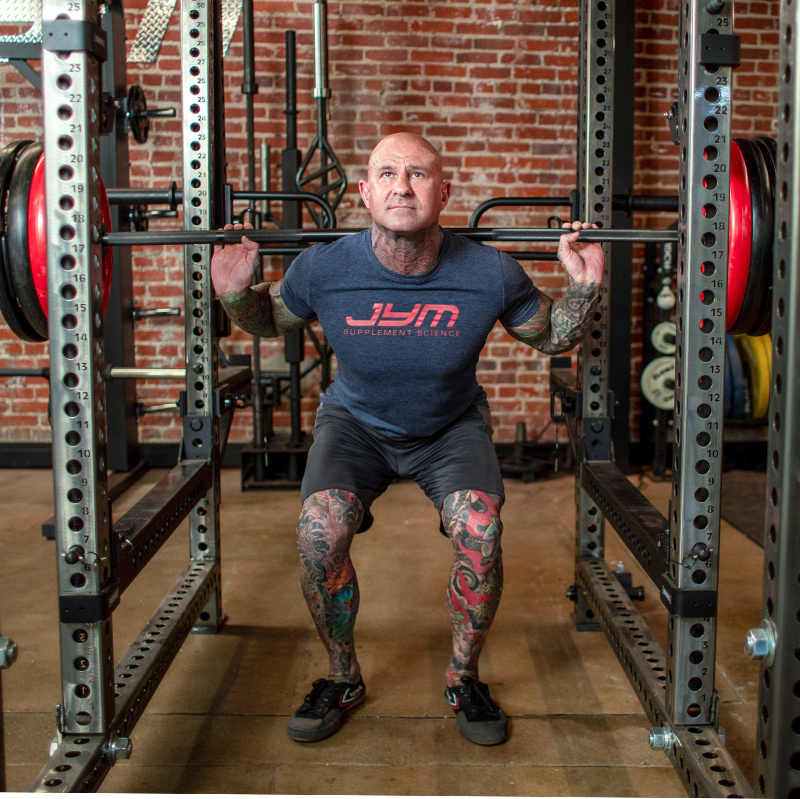
If you look around your gym, you may see people using a wooden block (2x4) or weight plate under their heels when doing squats. You may even notice bodybuilders wearing Timberland boots on leg day or Olympic lifting shoes with a raised heel.
Why do people do this? Because of the range of motion at the ankle. A lot of people just don't have good enough ankle range of motion to drop down into a deep squat. When this is the case, their heels start coming up off the floor at the bottom of each rep; as I mentioned above, this isn’t what you want.
If you’re lacking ankle flexibility, though, putting a 2x4 or weight plate under your heels will allow you to go down much lower without that forward bend at the spine – you’re able to keep your torso more upright and maintain a good center gravity as you go down into a deep squat.
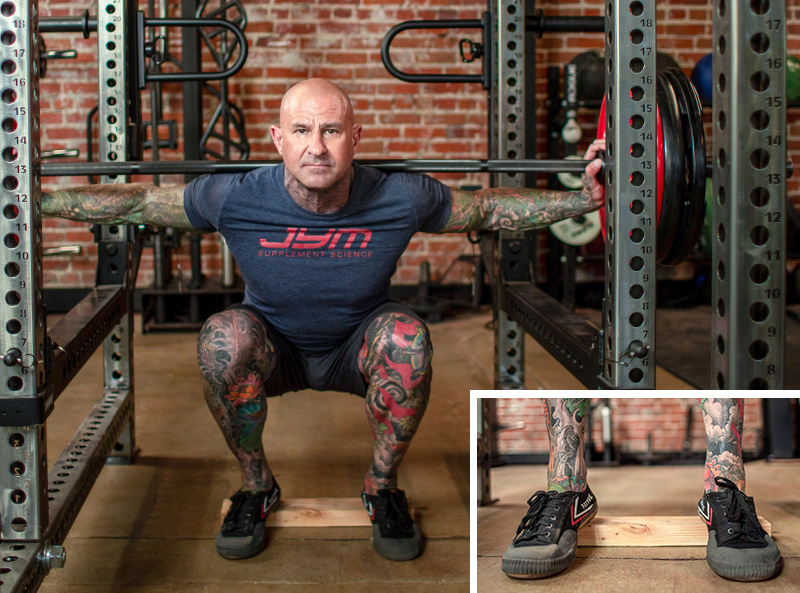
So definitely raise your heels on squats if you need to, but in the meantime, start working on your ankle flexibility by stretching out your Achilles tendons on a regular basis. Same with your hamstrings and glute/hip mobility; make sure you're working on your flexibility so that you’re eventually able to do a full squat without raising your heels with plates, 2x4s, or special lifting shoes.
Just make sure you do your static stretching AFTER your workout, not before. Before your workout, you want to be doing dynamic and ballistic stretching like high knee kicks. Save the long forward fold hamstring stretches for after training.
I’ll be honest, the Smith machine is really the last place you want to squat. Reason being, it doesn't mimic the biomechanics of the body, because when we squat, we're not just coming straight up and down like the guide rods on the Smith machine have you do.
So what’s the benefit of a Smith machine squat? The main benefit is being able to change up your foot position. When doing free weight barbell squats, your feet always have to be directly under the bar, right? You can't do a barbell squat with your feet more forward like you can in a hack squat. Well, you can on a Smith machine. And research shows that when doing a squat, the more your feet go in front of the bar, the more the hamstrings are involved; the further your feet go behind the bar, the more quad involvement you get.
The benefit of Smith machine squats, then, is for those who want to place more focus on the hamstrings. Don’t replace barbell squats with Smith machine squats – rather, add the latter later on in your workout as more of a hamstring exercise.
Find squats on Day 2 (legs and calves focus) of all four weeks of my Tabata Builder program, as well as MANY other programs here on JimStoppani.com.
Related Articles